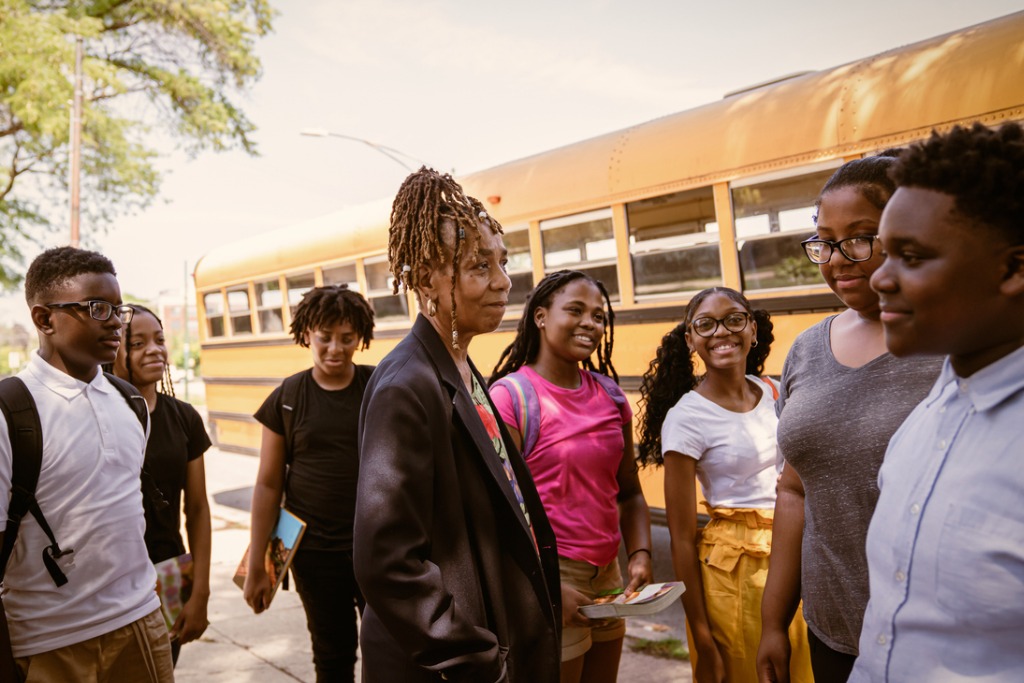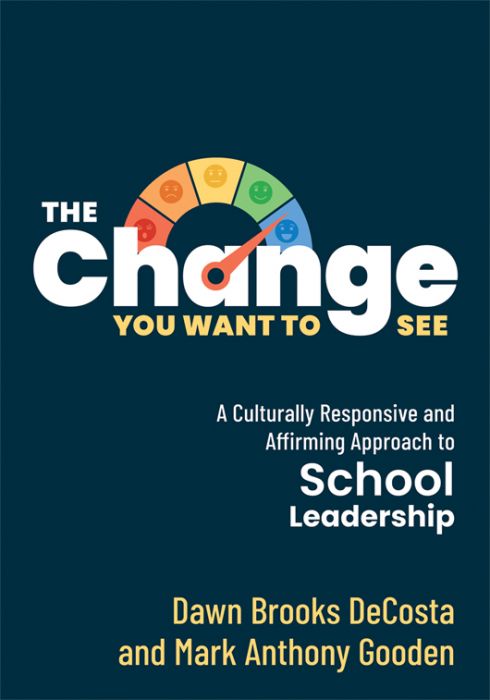In the past decade, Thurgood Marshall Academy Lower School transformed into a place where jazz plays in the hallways and students do yoga during lunch, all while improving academic performance. How? The principal at the time, TC alum Dawn Brooks DeCosta (Ed.D. ’17, Ed.M. ’08), enacted her framework for Culturally Responsive and Affirming Social Emotional Leadership and Learning (CRASEL), completely changing the school’s culture. A strong believer in the power of the CRASEL framework, Brooks DeCosta shares her wisdom in a new book, The Change You Want to See, written with her mentor, TC’s Mark Anthony Gooden, the Christian Johnson Endeavor Professor of Education Leadership.
The interactive, evidence-based book leverages the expertise of Gooden, who has nearly 25 years of experience preparing school leaders, and Brooks-DeCosta, who has decades of experience as a teacher, principal and now Deputy Superintendent of Community School District 5. As a result, it's a wealth of information about social emotional learning, culturally responsive leadership and much more.

Dawn Brooks DeCosta and Mark Anthony Gooden (Photos courtesy of authors)
We spoke with Brooks DeCosta and Gooden about their top tips for school leaders.
Get to know the context your students exist in
“Culturally responsive school leadership starts with critical consciousness. [School leaders] need to understand the history of the neighborhood their school is in and the complexity of how equity as a concept works. A leader who understands that knows that if kids haven't gotten everything they're supposed to, if they're living in substandard structures or if they're living in a community that's been impacted by redlining, they're not always going to be smiley and feeling good. When kids show up we have to have compassion.” -Mark Anthony Gooden
Build trust by embracing students’ identities
“I think social emotional learning [SEL] is good for humans, but it can be delivered in a way that disregards the identity of the child and everything they bring to the classroom. SEL has often been done in a color blind way, where people say ‘I'm not going to look at your identity, I'm only going to look at your emotions.’ It's not realistic and it doesn't create a trusting situation.
“We are all human beings with feelings. We get tired, we get sad, we want to be loved, that's universal. For SEL to be effective, we need to see people in their holistic selves. Culture, personal experiences, socioeconomic status — all of that impacts how students emote and if [they’re] gonna trust you enough to share their emotions, then you have to see and celebrate all parts of them.” -Dawn Brooks DeCosta

(Photo: iStock)
Focus on the assets of your school community instead of deficits
“We often fail to criticize systems that deprive people of resources while rushing to criticize people who are living in those spaces. So instead of saying, ‘We’ve got to fix these kids so they can get [high] test scores,’ we should start reframing the questions. What is it like to come to school in this space? How are we, as leaders, going to let you know we’re glad you made it? How can we show students that we will do everything you can to teach, motivate, and inspire them and won’t let people disparage their community?
“This is a part of community knowledge, which means recognizing the richness in a community, and doing everything we can to bring that into the school space is critical. We want to make sure we recognize all that our children and their parents bring.” -Mark Anthony Gooden
Instead of dismissing negative emotions, embrace them
“Sometimes you go into spaces with leaders and they say, ‘If the angry mom comes in, the first thing I do is de-escalate.’ Well, there's a caveat there. What if that angry mom has systematically been excluded from school? What if her mom and grandmother have been excluded from school? If that happens and they're angry and the first thing you say is, 'You should calm down,' how will they feel? Instead of de-escalating, parents need you to recognize and acknowledge their feelings. Emotions are welcome in the classroom, they speak to people’s humanity. And no, not everybody's going to be happy, but they certainly can be healthy and they can certainly find joy.” - Mark Anthony Gooden

(Photo: iStock)
Avoid internalizing criticism
“When I first became a principal, I had to learn how to not internalize what people were saying to me. Parents came at me in a way I was not prepared for and if you don't understand that it's not about you as a person, then you'll take it in, take it home, and then it becomes part of who you are. I learned really early on that was not going to be sustainable.
“When parents come to you with a complaint, something has happened and we need to acknowledge that something has happened. I have to be able to regulate and understand there's a whole picture here and while most of it has nothing to do with me, if you're the leader of the school, you're responsible for everything that happens in there.” -Dawn Brooks DeCosta
Treat everyone in your school community with respect
“I find that in my role supervising principals, tone is everything. It's not what you say. It's how you say it [and] how you make people feel. And if you've made me feel like you don't care what I have to say, or you're looking down on me, every time we have a conversation, it's gonna be difficult. It's really important to build those relationships and be vulnerable in conversations with families and staff…because nobody will be willing to follow your vision or collaborate with you if they feel like you don't respect them.” -Dawn Brooks DeCosta

